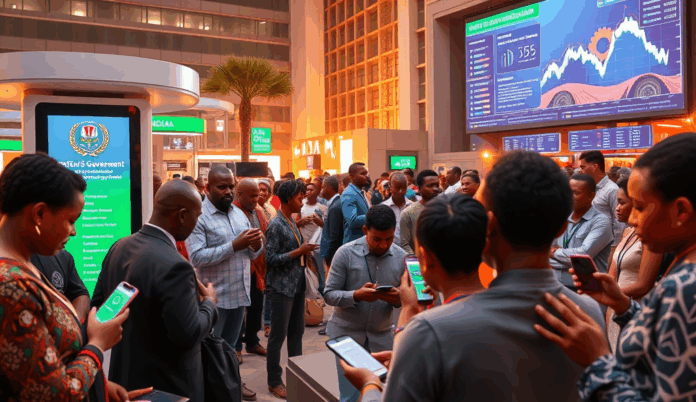Introduction to GovTech Digitization in Nigeria
GovTech digitization in Nigeria represents a strategic shift toward leveraging technology to enhance governance, with initiatives like the National Digital Economy Policy and Strategy (2020-2030) driving this transformation. The government’s focus on e-governance aims to streamline public service delivery, reduce bureaucratic inefficiencies, and improve transparency, as seen in platforms like the Treasury Single Account (TSA) and the Integrated Payroll and Personnel Information System (IPPIS).
Key digital infrastructure projects, such as the Nigeria Communications Satellite (NIGCOMSAT) and the National Identity Management Commission (NIMC) database, underscore the potential of GovTech to bridge service gaps. However, challenges like low internet penetration (42% as of 2023) and uneven digital literacy highlight the need for targeted interventions to ensure inclusive adoption across all regions.
As Nigeria advances its GovTech agenda, understanding the current state of public service delivery becomes critical to identifying digitization opportunities. The next section will examine these baseline conditions, setting the stage for discussing how technology can address persistent inefficiencies.
Key Statistics

The Current State of Public Service Delivery in Nigeria
GovTech digitization enhances efficiency by reducing manual processes as demonstrated by Nigeria’s IPPIS system cutting payroll fraud by 30% in 2022 while saving 12 billion Naira monthly.
Despite recent GovTech advancements, Nigeria’s public service delivery remains hampered by manual processes, with over 60% of citizen interactions still requiring physical presence, according to 2023 data from the Bureau of Public Service Reforms. Bureaucratic bottlenecks persist in sectors like business registration, where the World Bank ranks Nigeria 131st globally for ease of starting a business.
Critical services such as healthcare and education face uneven access, with rural areas experiencing 40% fewer government facilities than urban centers, per National Bureau of Statistics reports. While digital transformation initiatives like IPPIS have improved payroll management, legacy systems in ministries create interoperability challenges that delay service delivery.
These inefficiencies underscore why GovTech digitization must address both technological and structural gaps, as explored in the next section on its core components. The disparity between existing infrastructure and citizen needs highlights urgent opportunities for smart government solutions in Nigeria.
Understanding GovTech Digitization and Its Components
Despite the progress highlighted earlier Nigeria’s GovTech digitization faces infrastructural constraints with only 48% of the population having internet access as of 2023 limiting rural adoption of e-governance initiatives.
GovTech digitization integrates technology like AI, blockchain, and cloud computing into public services to streamline operations, as seen in Nigeria’s IPPIS system for payroll management. Core components include digital infrastructure upgrades, interoperable platforms, and cybersecurity frameworks to address legacy system challenges highlighted in previous sections.
For Nigeria, successful implementation requires localized solutions such as USSD-based services for rural areas with limited internet access, complementing urban e-governance portals. These components must align with structural reforms to overcome bureaucratic bottlenecks in sectors like business registration, where digital transformation lags behind global peers.
The next section explores how these technological and structural components collectively enhance service delivery, building on Nigeria’s existing GovTech initiatives while addressing gaps in accessibility and efficiency. This transition from theory to practical benefits underscores the urgency of holistic digitization.
Benefits of GovTech Digitization for Public Service Delivery
Estonia’s X-Road system demonstrates how interoperability can overcome siloed databases integrating 99% of public services digitally despite initial resistance similar to Nigeria’s IPPIS challenges.
GovTech digitization enhances efficiency by reducing manual processes, as demonstrated by Nigeria’s IPPIS system cutting payroll fraud by 30% in 2022 while saving 12 billion Naira monthly. Localized solutions like USSD-based services bridge the digital divide, enabling rural citizens to access birth registration and tax payments without internet connectivity.
Interoperable platforms streamline cross-agency collaboration, accelerating business registration from 10 days to 48 hours in Lagos State’s e-gov portal. Cloud computing and AI-powered chatbots in platforms like FIRS’ TaxPro-Max improve response times by 65%, reducing taxpayer complaints.
These advancements address legacy inefficiencies while creating accountability through blockchain-enabled transparency in contract awards. However, persistent infrastructure gaps and resistance to structural reforms pose implementation hurdles, as explored in the next section on key challenges.
Key Challenges to Implementing GovTech Digitization in Nigeria
Nigeria should adopt Estonia’s blockchain-based identity framework starting with a pilot in high-density states like Lagos and Kano leveraging lessons from their 98% adoption rate to address IPPIS resistance.
Despite the progress highlighted earlier, Nigeria’s GovTech digitization faces infrastructural constraints, with only 48% of the population having internet access as of 2023, limiting rural adoption of e-governance initiatives like USSD-based services. Power instability further complicates deployments, as evidenced by Lagos State’s e-gov portal experiencing 15% downtime monthly due to grid failures.
Resistance to structural reforms persists, particularly in payroll systems like IPPIS, where unions oppose biometric verification over job security concerns, delaying potential fraud reduction gains. Siloed databases across ministries also hinder interoperability, forcing agencies like FIRS to manually reconcile tax data despite TaxPro-Max’s automation capabilities.
Cybersecurity vulnerabilities remain critical, with Nigeria recording 3.5 million attacks on government platforms in 2022, undermining trust in blockchain-enabled contract transparency systems. These challenges highlight the need for adaptive strategies, as explored later through global case studies offering scalable solutions.
Successful Case Studies of GovTech Digitization in Other Countries
Sustainable funding models like Nigeria’s Digital Economy Intervention Fund which allocated ₦24 billion in 2023 demonstrate how pooled resources can scale successful pilots like Lagos’s e-procurement system nationwide.
Estonia’s X-Road system demonstrates how interoperability can overcome siloed databases, integrating 99% of public services digitally despite initial resistance similar to Nigeria’s IPPIS challenges. Their blockchain-based digital identity system, used by 98% of citizens, offers lessons for Nigeria’s cybersecurity concerns, having prevented major breaches since 2007 despite global threats.
India’s Aadhaar biometric system processed 1.3 billion enrollments, proving scalable solutions for rural populations with limited internet access—a model Nigeria could adapt for USSD-based services. The system reduced payroll fraud by 47%, showcasing potential gains Nigeria could achieve with union-backed biometric verification reforms in IPPIS.
Rwanda’s Irembo platform achieved 80% e-service adoption by combining offline verification centers with mobile payments, addressing power and connectivity gaps like Nigeria faces. Their phased rollout prioritized high-impact services first, a strategy Nigeria could replicate to build trust in blockchain-enabled systems while mitigating cybersecurity risks highlighted earlier.
Steps to Implement GovTech Digitization in Nigeria
Nigeria should adopt Estonia’s blockchain-based identity framework, starting with a pilot in high-density states like Lagos and Kano, leveraging lessons from their 98% adoption rate to address IPPIS resistance. Integrating USSD interfaces, as India did for rural Aadhaar enrollments, would bridge connectivity gaps for 40% of Nigerians without smartphones while reducing payroll fraud.
Following Rwanda’s Irembo model, Nigeria could prioritize digitizing pension verification and tax collection first, using mobile payment integrations like Paga or Flutterwave to boost trust in e-services. Offline verification centers at local government offices would ensure inclusivity, mirroring Rwanda’s 80% adoption success despite infrastructure challenges.
A phased rollout must include cybersecurity audits akin to Estonia’s X-Road system, embedding encryption protocols from inception to prevent breaches. Policymakers should collaborate with unions and tech hubs like Yaba to co-design solutions, ensuring buy-in for scalable GovTech transformation.
The Role of Government Officials and Policymakers in Driving GovTech Digitization
Government officials must champion digital transformation by aligning policies with practical implementation, as seen in Estonia’s blockchain adoption and Rwanda’s Irembo platform. Policymakers should mandate inter-agency collaboration, ensuring seamless integration of systems like IPPIS with emerging technologies such as USSD interfaces for broader accessibility.
Strategic partnerships with local tech hubs like Yaba and fintech firms like Paga can accelerate adoption, mirroring India’s Aadhaar success in bridging rural-urban gaps. Legislators must prioritize budget allocations for cybersecurity audits and offline verification centers, critical for safeguarding data integrity while ensuring inclusivity for Nigeria’s 40% offline population.
By fostering stakeholder buy-in through transparent co-design processes, officials can mitigate resistance, as demonstrated in Rwanda’s 80% e-service adoption. This groundwork sets the stage for evaluating how digitization enhances transparency and accountability, the focus of the next section.
Potential Impact of GovTech Digitization on Transparency and Accountability
Building on Nigeria’s push for inter-agency collaboration and cybersecurity measures, digitization can reduce corruption by creating auditable digital trails, as seen in Kenya’s e-procurement system cutting graft by 30%. Real-time transaction tracking through blockchain-integrated platforms like IPPIS would minimize payroll fraud, addressing Nigeria’s recurring ghost worker scandals.
Public dashboards for projects like Lagos’s e-procurement portal enable citizens to monitor contract awards and disbursements, replicating Georgia’s 90% reduction in bribery through open data policies. Such transparency strengthens accountability, as officials become answerable for digitally recorded decisions and expenditures.
These systemic shifts prepare the ground for sustainable funding models, which we’ll explore next as critical enablers for scaling these transparency mechanisms nationwide. Strategic partnerships will be key to maintaining momentum beyond initial pilot successes.
Funding and Partnerships for GovTech Digitization Initiatives
Sustainable funding models like Nigeria’s Digital Economy Intervention Fund, which allocated ₦24 billion in 2023, demonstrate how pooled resources can scale successful pilots like Lagos’s e-procurement system nationwide. Public-private partnerships with firms like Flutterwave for digital payment integration show how tech collaborations can reduce implementation costs while improving service delivery efficiency.
Multilateral partnerships with organizations like the World Bank’s Digital Economy for Africa initiative provide both funding and technical assistance, as seen in the $500 million support for Nigeria’s National Broadband Plan. These alliances ensure continuity beyond political cycles while embedding global best practices into local systems, from blockchain for transparency to AI-driven citizen engagement tools.
As these funding mechanisms mature, they create a foundation for the next phase of GovTech evolution—where integrated systems transform service delivery beyond isolated successes. This sets the stage for examining how sustained digitization will redefine Nigeria’s public sector in our concluding analysis.
Conclusion: The Future of Public Service Delivery with GovTech Digitization in Nigeria
Nigeria’s GovTech digitization efforts, from the Treasury Single Account to digital identity systems, demonstrate how technology can streamline governance while reducing corruption. With 73% of Nigerians now using mobile internet, the foundation exists for wider adoption of e-governance solutions like Lagos State’s e-procurement platform.
Strategic investments in digital infrastructure and cybersecurity measures will determine whether Nigeria achieves its Smart Government vision by 2030. States like Kaduna have shown progress through automated service portals, but nationwide interoperability remains critical for scaling impact.
The coming decade presents an opportunity to leverage emerging technologies like AI and blockchain while learning from global GovTech leaders. Sustained political will, public-private partnerships, and citizen-centric design will be key differentiators in Nigeria’s digital transformation journey.
Frequently Asked Questions
How can Nigeria ensure equitable access to GovTech digitization in rural areas with limited internet connectivity?
Implement USSD-based services like India's Aadhaar system and establish offline verification centers at local government offices to bridge the digital divide.
What strategies can mitigate resistance to structural reforms like IPPIS biometric verification among public sector unions?
Adopt Estonia's co-design approach by involving unions in solution development and demonstrating fraud reduction benefits through pilot programs with transparent results.
How can Nigeria address cybersecurity risks in GovTech platforms given the 3.5 million recorded attacks in 2022?
Implement Estonia's X-Road encryption protocols and conduct mandatory quarterly cybersecurity audits for all government digital systems.
What funding models are most sustainable for scaling successful GovTech pilots nationwide?
Combine Nigeria's Digital Economy Intervention Fund with World Bank partnerships and revenue-sharing agreements with private fintech partners like Flutterwave.
How can policymakers ensure interoperability between siloed systems like IPPIS and TaxPro-Max?
Mandate API integration standards across ministries and create a central data governance framework similar to Estonia's X-Road system.


